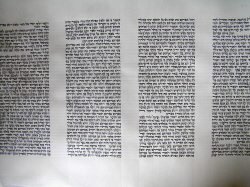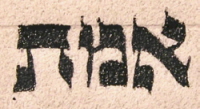Sukkah-building. Ink in foreground.
The Soferet likes a bit of human interaction now and again, and so on Thursday I was working in the library of the Jewish Theological Seminary here in New York.
There's a bit of the library which is set up as a beit midrash, with Talmud volumes instead of the usual academic books. It's got great big windows, and most of the time it's very quiet. (The real beit midrash is elsewhere, you see. Underground, so the light isn't as good. But with free tea. I might work there next week.)
A young woman passed by and did a double-take: quill and ink? what is that happening there? crikey, it looks like Torah... and we ended up having a nice conversation, in which she mentioned that she'd never before seen a Torah in the process of being written, and indeed had never really thought about how the Torah gets to be the way it is.
A soferet's job is like that. You work in the background, doing your job, and when it's done, all attention is on your product, the shiny new Torah, and perhaps you deliver it and interact with the community and perhaps not, but in any case afterwards you fade back out and the Torah takes over.
Personally, I don't mind this - I also enjoyed stage-managing in college - but what grabbed me particularly was that outside the lovely big windows, the JTS ground staff were building a sukkah, ready for the Sem to use next week. Next week perhaps the students will have sukkah-decorating and perhaps they won't, but the actual building of the sukkah took place, like much Torah-writing, in the background, so that next week the sukkah will be ready for use and the ground staff will have faded into the background.
So, that was a nice parallel, last Thursday. Me inside, writing Torah more or less unseen, and them outside, building a sukkah more or less unseen, setting the stage for the pageantry of Sukkot and Simchat Torah, upon which the curtains will open next week.

 The text of the Torah is written out in columns, as I expect you know. Our Torah will have 245 columns*.
The text of the Torah is written out in columns, as I expect you know. Our Torah will have 245 columns*.
 Reish or dalet?
Reish or dalet? Middle letter: khaf or beit? Kvar or kikar?
Middle letter: khaf or beit? Kvar or kikar?

